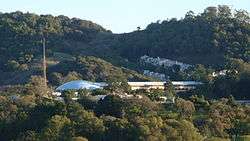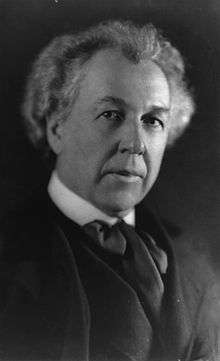Marin County Civic Center
|
Marin County Civic Center | |
|
The Marin County Civic Center | |
  | |
| Location | San Rafael, California |
|---|---|
| Coordinates | 37°59′59″N 122°31′48″W / 37.99972°N 122.53000°WCoordinates: 37°59′59″N 122°31′48″W / 37.99972°N 122.53000°W |
| Built | 1960 |
| Architect | Frank Lloyd Wright |
| Architectural style | Modern Movement |
| NRHP Reference # | 91002055[2] |
| CHISL # | 999[1] |
| Significant dates | |
| Added to NRHP | July 17, 1991 |
| Designated NHL | July 17, 1991[3] |
The Marin County Civic Center, designed by Frank Lloyd Wright, is located in San Rafael, California, United States. Groundbreaking for the Civic Center Administration Building took place in 1960, after Wright's death and under the watch of Wright's protégé, Aaron Green, and was completed in 1962. The Hall of Justice was begun in 1966 and completed in 1969. Veterans Memorial Auditorium opened in 1971, and the Exhibit Hall opened in 1976.
Located away from the former county seat in downtown San Rafael, the expansive complex stretches across two valleys just east of US 101. Its pink stucco walls, blue roof and scalloped balconies are distinctive. The smaller wing is the county administration building and the larger the Hall of Justice, joined by a round structure on a small hill that houses a county library.
A battle between factions of the Marin County Board of Supervisors played out through the selection of the site and the architect, the financing of the project, and its eventual completion. The Marin County Civic Center is a state and National Historic Landmark. The main Civic Center building has been nominated for the UNESCO World Heritage List[4] as a part of ten properties by Frank Lloyd Wright. The nearby fairgrounds host the Marin Sonoma Concours d’Elegance[5] each spring; they host the Marin County Fair[6] each July.
Architecture
The selection of Frank Lloyd Wright in 1957 to design the Civic Center was controversial. The Civic Center project was Wright's largest public project, and encompassed an entire campus of civic structures. The post office was the only federal government project of Wright's career. Wright's design borrowed ideas and forms from Wright's Broadacre City concept, first published in 1932.[7]
Main building
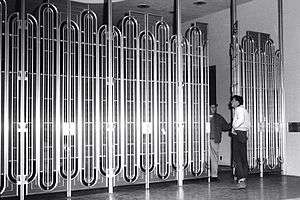
The principal structure consists of a four story 580-foot (180 m) long Administration Building and a three story 880-foot (270 m) long Hall of Justice at a lower elevation, joined at an 120 degree angle at an 80-foot (24 m) diameter rotunda. The Hall of Justice spans a small valley, arching twice over an access road and a parking area, while the Administration Building spans a smaller ravine. Both structures are entered through archways on their lower levels. The long principal facades are marked by shallow non-structural arches of decreasing span with each story. The arches, which are framed in metal with a stucco appliqué, overlap slightly at the lower level. On the intermediate level they appear to stand on short slender gold-anodized columns, and on the top level they become round openings with gold railings directly under the deep roof overhang. The railings themselves have a circular pattern. The bright blue roof is itself patterned with arched cut-outs and raised circular patterns The building wings are arranged as a barrel vault shape on either side of the central galley, asymmetrically disposed. Interior guardrails at the atrium are solid stucco with no metal elements. Entrances are controlled by vertical grills of gold-anodized metal with rounded tops and bottoms, rather than doors. The eaves are embellished with an arched fascia with small gold balls inset in each arch, a pattern repeated in the atria.[7]
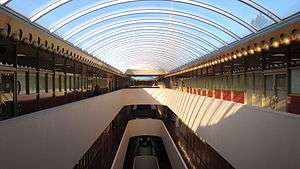
The rotunda on the central hill houses the county library and a central cafeteria. Its 172-foot (52 m) gold spire was meant to house a radio transmitter, as well as the boiler plant's chimney. The interiors are arranged around open atria or "malls" as Wright called them, which allow natural light into the space. Originally open to the sky, the malls were later covered with skylights designed by William Wesley Peters.[7] Interior spaces featured glass walls to allow light to penetrate from the exterior and the atrium, and to follow through on Wright's philosophy of maximum openness of government activities.[8]
Wright's concept envisioned a gold-colored roof, which proved to be impossible to obtain in a long-lasting material. After Wright's death, Olgivanna Wright chose a bright blue color that would weather well, gaining a softer color with age. The color choice, together with the pink stucco walls, was initially controversial, causing the building to become known as "Big Pink." The only large gold element is the spire at the rotunda.[9]
Accessory buildings
The Post Office building is a one-story elliptical building near the entrance to the complex. Its facade repeats the arch motif, with circular embellishments on its canopy. The interior features and elliptical lobby.[7]
The nearby Veterans Auditorium was designed by the Taliesin Associated Architects and was completed in 1971 in a manner compatible with the main complex.[7] The auditorium was designed for use by the county fair with a combination of flat-floor exhibition space and tiered seating spaces, using a compromise plan devised by Wesley Peters, George Izenour, and Aaron Green.[10] The main hall seats 1960[11] in an amphitheater arrangement. A separate Showcase Theater seats 300, and the exhibition hall can accommodate up to 2000 patrons.[12]
The original Hall of Justice design incorporated the Marin County Jail. As the jail outgrew its space a number of proposals were advanced for a new facility adjoining the Civic Center. A new, mostly underground jail was completed in 1994 in the hilltop immediately to the west of the Hall of Justice, designed by AECOM with 222 cells and 363 beds. The jail connects to the Hall of Justice by an underground link.[13] The design concept was originally suggested by Aaron Green.[14] The final design was reached after unsuitable underground and above-ground designs were rejected in the 1980s.[15] Natural lighting of interior spaces is provided by skylit light wells over the common space of each of six pods.[16]
Politics
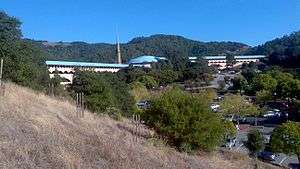
The Marin Civic center arose from a desire to consolidate county services at a single location, away from the center of San Rafael. The idea was combined with a proposed county fairground, and 140 acres (57 ha) of the Scettrini ranch were purchased in 1956 for $551,416 along U.S. Highway 101 near Santa Venetia. The same year a selection committee was convened to select an architect, interviewing 26 firms, with a strong showing from Richard Neutra. Frank Lloyd Wright was not interviewed, and had indicated that he would not participate in a competitive selection. At the instigation of supervisor Vera Schultz, committee members and four county supervisors met Wright in June 1957 when he visited Berkeley to lecture at the University of California. On June 27 the Board of Supervisors voted 4-1, with Supervisor William Fusselman dissenting, to retain Wright. Wright arrived in San Rafael two days later. He was 90 years old.[7]
Opposition to Wright's appointment was immediately apparent. The holdout supervisor represented a conservative base that was opposed to the rapid pace of change in Marin County and to the proposed move from the center of San Rafael. Wright's fee of 10% of the construction cost drew criticism, as it was 2% higher than that proposed by other firms. Fusselman found a supporter in Wisconsin State Assemblyman Carroll Metzner, a virulent opponent of Wright in Wisconsin who appeared with Fusselman on local radio in Marin to denounce Wright's "socialist" design philosophy. Fusselman was also supported by the local chapter of the American Legion. At the board meeting that confirmed Wright's appointment Legionniare Bryson Reinhardt read into the record a denunciation of Wright as a supporter of Communism during World War II, prompting an angry response from Wright, who threatened to walk away from the project. The county clerk, a Fusselman ally who had helped to organize the Legionnaires' protest, lost Wright's contract. A carbon copy of the contract was signed by the president of the Board of Supervisors, and Wright stayed.[17] Opponents demanded a referendum on the design, which was counteracted by an effective public relations campaign by supporters. Wright was directed to proceed with detailed design on April 28, 1958. In March 1959 Wright was appointed to design the post office. On April 9, 1959, Wright died, aged 92. Supervisor Fusselman attempted to obtain the plans as they were at Wright's death and to cut the fee by 2%. Both efforts were unsuccessful. Design of the first phase was complete in September 1959, directed by Wesley Peters and Aaron Green. The low bidder was Rothschild, Raffin and Weirick of San Francisco for $3,638,735 for the building and $596,470 for site development.[7]
Ground was broken on February 15, 1960 at a ceremony attended by Wright's widow, Olgivanna, Wright's son Lloyd Wright and grandson Eric Lloyd Wright, but not by Fusselman.[8] The June 1960 election changed the makeup of the Marin County Board of Supervisors so that, in the following January, the new board voted to halt work on the project and possibly to convert it for use as a hospital, to replace a hospital that had been condemned.[8] However, a poll by the Marin Independent Journal showing overwhelming support for the project pressured board members to change their minds. This, together with a negative report on conversion to hospital use by an independent architectural firm led to the lifting of the stop-work order, construction resumed a week later.[18] The contractor sued for time and money lost during the stoppage.[8] There was no further political opposition. The post office was the first building to be completed, and was dedicated on May 19, 1962. The Administration Building was dedicated on October 13, 1962, again without Fusselman.[7][8]
The Hall of Justice was financed by a special bond passed by referendum in 1965, which allocated $7,750,000 to the $11,756,000 cost of the new wing. Work by the contractor, Robert E. McKee of Dallas, Texas, was scheduled to be complete by October 1968. Strikes, bad weather, delivery problems for materials and design changes pushed the proposed completion to July 1969. The Hall of Justice was finally dedicated on December 13, 1969.[8]
Landmark designation
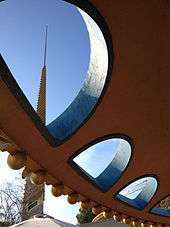
The Marin County Civic Center main building was designated a National Historic Landmark on July 17, 1991,[3] and was listed on the National Register of Historic Places the same day,[2] in recognition of its exceptional design. The designation came only thirty years after completion of the first phase, compared with the more usual 50-year term before a site is considered for NHL designation. It is also a California Historical Landmark, Number 999,[1] and is, with other Wright buildings, being considered for designation as a UNESCO World Heritage Site.[4][19]
Attacks
In August 1970 the Civic Center, which houses the Marin County Superior Court, was the scene of an attempted jailbreak led by Jonathan Jackson, the brother of Black Panther militant George Jackson, demanding the release of the so-called "Soledad Brothers". Jackson released several prisoners in the courtroom and the group took a number of hostages, including the presiding judge, Harold Haley. While they were attempting to escape, four people, including Judge Haley and Jonathan Jackson, were killed. The story, which featured dramatic photographs, was carried in newspapers nationally.[20][21] Black Panther activist Angela Davis was eventually tied to the case, prompting her to go on the run before being caught and ultimately acquitted on charges of supplying firearms to Jonathan Jackson.[22] Aaron Green designed a landscaped area near the Hall of Justice as a memorial to Judge Haley.[23] Later that same year, in October 1970, the WUO detonated a bomb at the Courthouse in retaliation.[24]
Popular culture
The Civic Center has an interesting relationship with science fiction. It was a filming location for director George Lucas's first feature-length film THX 1138 in 1971. Coincidently, also in 1971 on November 17, the science fiction author Philip K Dick came to the police office, that was located in the building at the time, to report the theft of all his personal papers. Explosives were used to open his 1,100 pound fire proof safe.[25] "He was convinced it was the CIA. This troubling event starts a paranoia in Dick's mind."[26] Later, Lucas would use elements of the Civic Center design in the design of structures on Naboo in the Star Wars universe.[27] The exterior and interior views of the buildings were featured in the 1997 film Gattaca.
The building also has a relationship with music. Parts of Peter Frampton's 1976 multi-platinum selling live album Frampton Comes Alive! were recorded during his performance at the Marin County Civic Center on June 13, 1975. The Grateful Dead recorded their 1987 album In the Dark in front of an empty house at the Marin Veterans Memorial Auditorium.[28] Exterior views were pictured in the music video for the song "I Need a Doctor" by Dr. Dre from his album Detox.
Gallery
 Looking up at the Civic Center.
Looking up at the Civic Center.- Marin Transit serves the Civic Center.
 The spire atop the Civic Center.
The spire atop the Civic Center. A view of the roof.
A view of the roof. Marker for the Civic Center.
Marker for the Civic Center. The red tile features Frank Lloyd Wright's signature.
The red tile features Frank Lloyd Wright's signature. National Register of Historic Places marker.
National Register of Historic Places marker.
References
- 1 2 3 "Marin County Civic Center". Office of Historic Preservation, California State Parks. Retrieved 2012-10-09.
- 1 2 National Park Service (2010-07-09). "National Register Information System". National Register of Historic Places. National Park Service.
- 1 2 "National Historic Landmarks Program". tps.cr.nps.gov. Retrieved March 15, 2015.
- 1 2 "Frank Lloyd Wright Buildings". World Heritage Center: Tentative Lists. UNESCO. Retrieved May 10, 2012.
- ↑ "Marin Sonoma Concours d'Elegance web site". Retrieved September 12, 2013.
- ↑ "Marin COunty Fair". Retrieved September 12, 2013.
- 1 2 3 4 5 6 7 8 Woodbridge, Sally B. "National Historic Landmark Nomination Form: Marin County Civic Center" (PDF). National Park Service. Retrieved May 9, 2012.
- 1 2 3 4 5 6 "A Place for the People's Government". Marin C9ounty Historical Society Bulletin. March 1990.
- ↑ Green, p. 94
- ↑ Green, pp. 104-105
- ↑ "Marin Veterans' Memorial Auditorium". San Rafael Patch. Retrieved May 10, 2012.
- ↑ Rapaport, Richard (February 1, 2011). "Frank Lloyd Wright's Civic Center Flip Side". San Rafael Patch. Retrieved May 10, 2012.
- ↑ "Marin County Jail". AECOM. Retrieved May 10, 2012.
- ↑ "Marin County Civic Center Designed by Frank Lloyd Wright". Marin County. Retrieved May 10, 2012.
- ↑ Goldberger, Paul (March 25, 1990). "Architecture View; The Jailhouse Blues: The Ballad of the Marin County Jail". New York Times. Retrieved May 10, 2012.
- ↑ Rapaport, Richard (December 24, 2010). "The Marin County Civic Center Part I: The Jail: Wright or Wrong". San Rafael Patch. Retrieved May 10, 2012.
- ↑ Rapaport, Richard (January 13, 2011). "The "Wright Summer" of 1957". San Rafael Patch. Retrieved May 10, 2012.
- ↑ Green, p. 75
- ↑ Rapaport, Richard (January 25, 2011). "Getting Onboard the World Heritage List". San Rafael Patch. Retrieved May 10, 2012.
- ↑ Associated Press (August 8, 1970). "Courtroom Escape Attempt/Convicts, Trial Judge Slain". Sarasota Herald.
- ↑ Walsh, Jason (August 6, 2010). "A shock to the system". Pacific Sun.
- ↑ Burns, Alex (June 24, 2003). "Angela Davis defined a revolution". Miami Times.
- ↑ Green, pp. 102-103
- ↑ https://books.google.com/books?isbn=1136806555
- ↑ The Gospel According to Philip K. Dick at the Internet Movie Database
- ↑ Margot, Joel. "Brief Biography of PKD". http://www.gnosis.org/pkd.FAQ.bio.html. The Gnosis Archive. Retrieved February 17, 2015. External link in
|website=(help) - ↑ "Marin County Civic Center Self-Guided Tour" (PDF). Marin County. Retrieved May 10, 2012.
- ↑ In the Dark - at deaddisc.com. Retrieved June 11, 2016
Bibliography
- Green, Aaron G. and de Nevi, Donald P. An Architecture for Democracy: The Marin County Civic Center, Grendon Publishing, 1990. ISBN 0-9625029-1-X
External links
| Wikimedia Commons has media related to Marin County Civic Center. |
